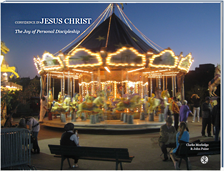Time for another installment of looking back at a trip my wife and I took this past Christmas to Europe…. I know we are now in mid-April and spring is here, but I still have Christmas on my mind.
Ah, Belgium! Waffles and fries! Unfortunately, both my wife and I got sick within a few days after arriving in Belgium. At first, I was still in better shape than she was, and I was pretty determined to make the most out of our Christmas adventure in Europe. So, while she rested up, I went with our friends Andrew and Shannon to take a “World War 1 & 2” tour day.

Clarke with friends Andrew and Shannon, in front of Cloth Hall, in Ypres, Belgium, which was restored after WWI. A fantastic museum in the Cloth Hall chronicles the story of the Western front in WWI, and the town of Ypres was right on the front lines of the action.
It was only about an hour’s drive from where our friends were living (a bit southwest of Brussels) to get to Ypres, a town that dates back to Roman times, which has seen more than its fair share of battles over the centuries. But the worst of it was in World War I, where Allied (French, British, Canadian, and eventually American) forces exchanged machine gun fire with German forces, in an exhausting effort to move the front line, one way or the other. When Belgium was attacked by Germany in 1914, it triggered a series of alliance treaties which catapulted France and the British Empire into the war, and within weeks Ypres became a highly contested piece of real estate, a situation which lasted pretty much the entire war lasting four long years.
Ypres was one of the first sites on “the Western front” where chemical weapons, such as chlorine and mustard gas, was first used as a weapon of war. April 22, 1915 marks the day when during the Second Battle of Ypres a war power (Germany, in this case) first successfully used chlorine gas to dislodge enemy troops. While chemical weapons are technically outlawed by international law now, such was not the case during World War I.
Yet the most bloody battle was the Battle of Passchendaele, where Allied forces were able regain just a few miles of territory from the Germans, but at the cost of some half a million casualties. Well over a million battle casualties happened among the Flanders Fields surrounding Ypres during the course of the war, with dozens of cemeteries scattered across the area, where people still visit today. Ypres is once again a beautiful place now, but a little over a hundred years ago, it was devastation. The town was almost completely flattened, and the towering Cloth Hall, pictured above was almost all but obliterated (see below):

Cloth Hall Tower, Ypres, [ca. 1918], Photographer Unknown, Canadian Expeditionary Force albums, Reference Code: C 224-0-0-9-1, Archives of Ontario, I0004760
After touring the museum at the restored Cloth Hall in Ypres, we drove yet another hour west to the English Channel, at Dunkirk, a port and beach resort town in France, for a stop to think about World War II. The story of Dunkirk is most remembered as the last place the retreating British Expeditionary force stood on mainland Europe’s soil in 1940, in the face of encroaching and overwhelming German troops. The then new British Prime Minister, Winston Churchill, insisted that remaining French troops be rescued, along with British troops, and this whole story is associated with the call for private shipping vessels to assist in the miraculously successful evacuation of thousands of military personnel across the English Channel.

The beaches of Dunkirk, France. Thousands of British, and eventually French troops waited on these beaches to be evacuated across the English Channel, as they faced a superior German fighting force, in 1940, in the early years of WW2.
Standing on the beaches of Dunkirk, which in the typical summer months is still a popular resort location, it was hard for me to imagine the helpless feeling many of those soldiers felt, pinned down on these beaches, as occasional German fighter planes sought to strafe the beaches, with RAF fighters in pursuit.
You would think that the horrors of the great world wars of the 20th century would have convinced humanity that guns and bombs do not solve social problems, but the human rebellion against the ways of Christ demonstrate that we are all in need of a Savior. Followers of Jesus do not all agree on how to respond to the dilemmas which wars present, but to make an end of them should be our ultimate goal. While chemical weapons are still a concern, the even more terrible threat comes with nuclear weapons, and there are credible rumors that such weapons might be developed to be used in space, to knock out satellites and cause electromagnetic surges, that can wipe out sensitive electronics here on earth, putting the lives of those who depend upon such sensitive electronics at tremendous risk. With two other major wars happening across the globe right now; namely, the Israeli/Gaza war and the Ukraine/Russia war, there is much that Christians can do to pray for peace. We live in difficult, difficult times.
One more reflection about Ypres is in order….
Ypres was also one of the sites where the “Christmas Truce” of 1914 was celebrated, a brief respite from the atrocities of war, as French, British, and Germany soldiers put down their rifles and played soccer in “No Man’s Land.” Folk singer John McCutcheon wrote a song about the “Christmas Truce,” which is one of my favorites.
I will have a few more posts looking back on our trip to Europe this past Christmas later in the spring.

